Don’t get caught doing something embarrassing in Japan! We’ve compiled some important Japanese etiquette and manners to keep in mind while eating, riding trains and other common activities.

When traveling in a country other than your own, it is always a good idea to do a little research on what is polite so that you don’t accidentally offend or exhibit a social faux pas.
Etiquette is extremely important in Japan. Japanese people are quite conscientious about minding their manners. As a visitor you’re expected to follow the same rules.
It is understandable if you occasionally slip up, but it is a good idea to read over these tips so you don’t end up in an embarrassing situation (we’ve definitely been there!).
In this article we’re covering basic Japanese etiquette from manners for eating in public to how to behave in onsens and on trains.
Japanese etiquette guide
- General etiquette in Japan
- Etiquette for eating in Japan
- Train etiquette
- Onsen etiquette
- Etiquette for visiting shines & temples
General manners and etiquette in Japan
Here are a few general manners to keep in mind when traveling to Japan.
1. Don’t eat while you walk

In Japan, eating while you walk is considered sloppy and is often associated with a lack of manners. It’s funny because I didn’t realize how often we do this until we were in Japan and found ourselves wanting to snack on the go.
We spoke with a local who said this “unwritten rule” is starting to change a bit with younger generations in the major cities, but it’s still a good idea to try your best to avoid eating on the street.
Many convenience stores have areas for you to stand and eat before going on your way. They’ll usually also have trash bins, which aren’t as common on the streets of Japan.
2. Don’t point
Pointing is generally frowned upon in Japan as it can be perceived as impolite or even aggressive. Instead, use an open hand to make gestures.
3. Don’t blow your nose in public
Blowing your nose in public is considered unsanitary in Japanese culture. If you need to address a runny nose, it’s more acceptable to discreetly use a tissue or handkerchief in a private space. Japanese people often go into the bathroom to blow a stuffy nose.
4. Know when to take off your shoes
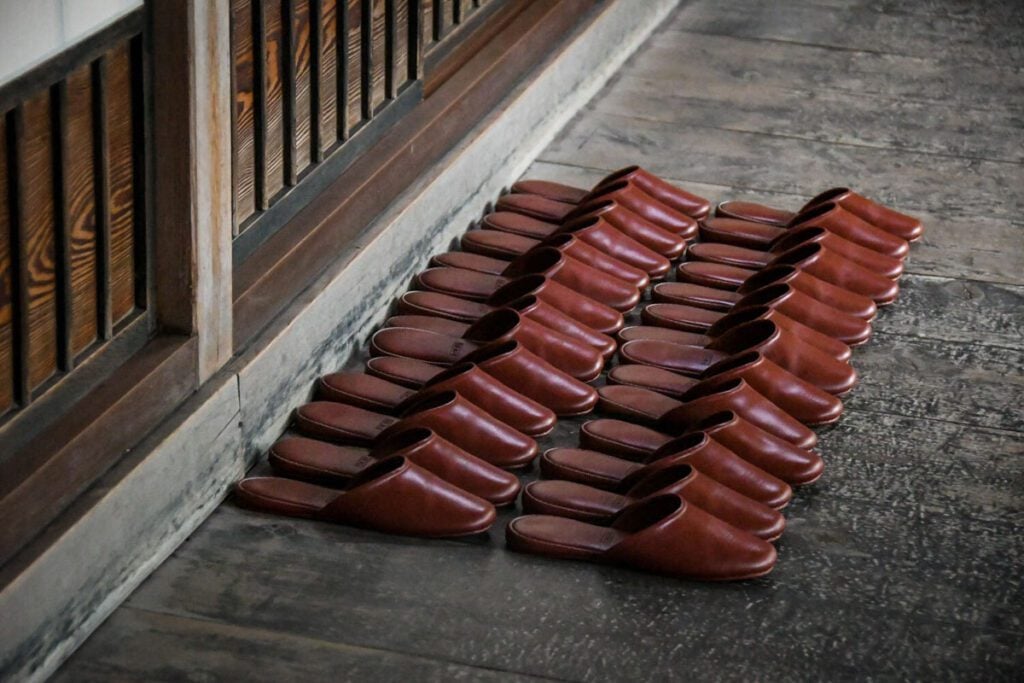
Taking off your shoes indoors is common courtesy in Japan. It signifies respect for cleanliness and the desire to keep living spaces pristine.
When entering guesthouses, homes, holy sites, and some stores, you will need to remove your shoes. This is typically indicated by floor that is different levels — either raised or lowered once you enter.
5. Don’t forget to take off your bathroom slippers
As with above, is a restaurant or business in Japan requires you to remove your shoes, they will often provide bathroom slippers to use in their facilities.
If you are running on auto-pilot, it can be easy to forget to remove the bathroom slippers when you exit the toilet to walk back to your table. However, this is considered to be an extremely embarrassing mistake. So do your best not to forget!
6. No smoking while walking
Smoking while walking is generally frowned upon in Japan, and in some areas completely illegal. It is seen as inconsiderate and harmful to others sharing the sidewalk.
Smokers are encouraged to use designated smoking areas or to find a quiet spot away from foot traffic to enjoy their cigarettes.
7. Know how to say “excuse me”
Trust me, this will come in handy whether to get your waiter’s attention, or as you’re moving through a crowded area and you need to pass by someone.
Sumimasen can be used in many situations and should be one of the Japanese phrases you memorize.
On that note, we have a whole list of practical Japanese words and phrases (that you can actually use!) for traveling in Japan.
Etiquette for eating in Japan
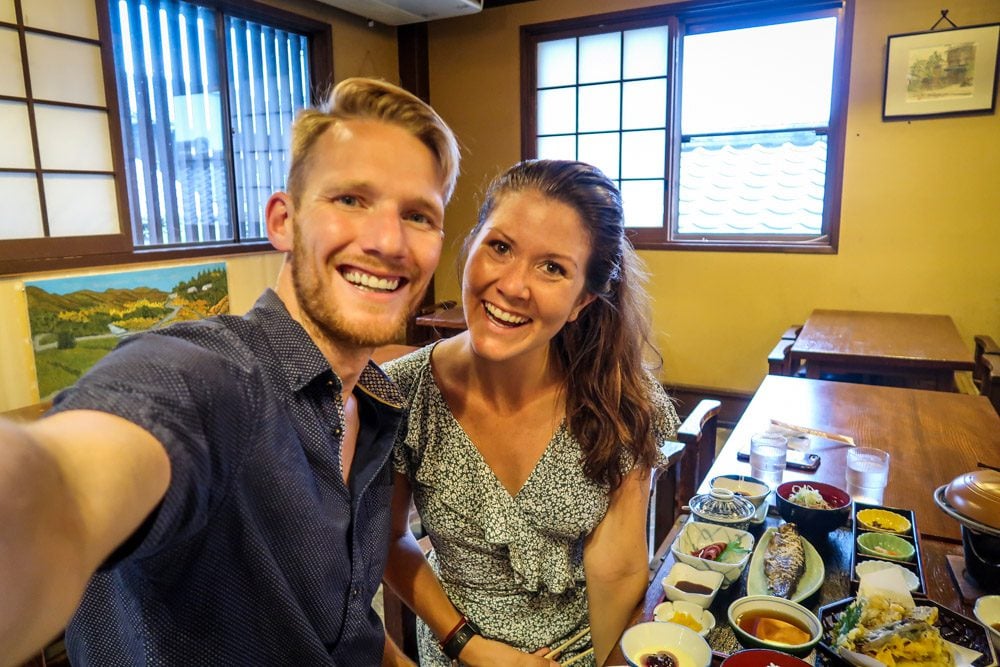
If you choose to eat out in public in Japan, it’s a good idea to keep these manners in mind.
8. Remove your shoes if necessary
Some restaurants will have a shoe rack at their entrance. If this is the case, it is a signal to remove your shoes and to go barefoot.
9. Know what to do with the oshibori

At almost every meal, you’ll receive a wet washcloth (or a moist towelette packet). In the summer, the cloths will be cold and in the wintertime they’re hot.
This is called an oshibori, and it is for cleaning your hands before a meal.
Do not use this to wipe the sweat from your brow. We made this mistake during a sweltering August day and learned it is considered very rude.
Instead, use this to wipe your hands and fold it up again. It can be used discreetly to wipe hands during meals, but should stay on the table (not your lap).
10. Slurping is okay

That’s right – in some Western countries, slurping is seen as rude, but in Japan it is a sign you are enjoying your meal. It also allows you to eat piping hot noodle soup while kind of cooling it down a bit.
11. Don’t blow your nose at the table
If that hot noodle soup is making your nose run (yep, totally been there!), excuse yourself to the bathroom to blow your nose. It is considered rude to do this at your table.
12. Be mindful with your chopsticks

When using chopsticks, it’s important to know a couple of taboos. Here are some “don’ts” when it comes to chopstick etiquette:
- Don’t use them to point or to do anything other than get food into your mouth!
- Don’t leave them inside of a bowl sticking upright. The reason for this is it resembles a funeral ritual and supposedly brings bad luck. (Common in many Asian countries.)
- Don’t pass food from your chopsticks to someone else’s chopsticks.
- Don’t stab your food with chopsticks.
- Don’t suck on your chopsticks.
- Don’t rest your chopsticks by crossing them on top of each other. Instead, place them side by side on the chopstick rest.
13. Know how to signal for the check
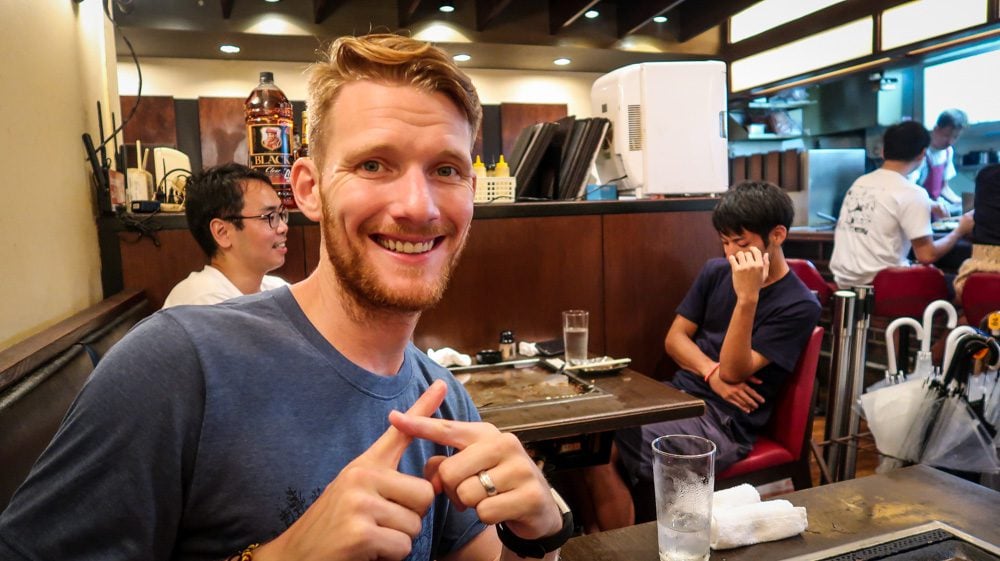
If you’re dining in a casual restaurant and would like to ask for the check, make eye contact with a staff member and form an “x” by crossing your two index fingers.
This is too casual for a nicer restaurant, so in those cases, you can ask for the check by saying, “O-kaikei onegai shimasu”, which translates to “check plese”.
14. Don’t tip
Tipping is not part of Japanese culture, so save your yen and don’t leave a tip. In some cases, it can even be taken as a slight insult.
And even if the server is not offended, they will likely be confused. So save your yen and don’t leave a tip.
15. Don’t try to split the check

Sometimes when we’re traveling on a budget, we like to split one large meal. Often times, we don’t feel the need to order two full entrees, plus, it cuts our food costs in half.
However, this is usually considered rude in Japan since seating is often limited and you are taking up a spot in the restaurant.
So for instance, it would be frowned upon for two people to go into a ramen shop at a busy hour, and only order one bowl of soup. If one party doesn’t feel like eating, it would be best to wait outside (I know, I know!).
Japanese etiquette on trains

Take a look over this list to make sure you don’t embarrass yourself on the Japanese trains!
16. Don’t eat on local trains
Japanese people are very mindful of where they eat, and you won’t see anyone eating on local trains.
The exception to this rule is on Shinkansen (bullet trains), which are typically longer journeys. You’ll usually see locals eating food, which gives you the signal that it’s okay.
17. Be quiet

You’ll notice that even super packed trains in Japan are eerily quiet. If you’ve ever ridden the trains in India, this is the exact opposite!
Don’t be that person who is talking loudly to your partner or watching Netflix without headphones! Keep your noise level to a minimum.
18. Don’t litter
I don’t think this needs much explanation. Be sure to grab everything you brought onto the train—trash included—and take it with you when you exit.
Trash bins aren’t very common around Japan, so you should plan to carry your wrappers and other garbage until you find one or get to your hotel room.
19. No smoking
On some Shinkansen trains, which are typically longer journeys, there is a designated smoking car. Other than that, it is strictly prohibited.
20. Be mindful of priority seating

There are signs marking seats for the elderly, pregnant, or those in need. It is okay to sit here if there is nobody in need. However, we preferred to avoid sitting in these sections just to be extra cautious.
21. Don’t take up excess seats
Unless the train is very empty with plenty of seats, don’t set your belongings on the seat next to you. Instead, store it overhead or in a designated luggage section in the car.
You can also set it on your lap or put it at your feet, but do your best to leave seats available for others to use.
22. Don’t put your feet up
In many Asian cultures, feet are seen as dirty, and propping them on the seat is considered rude.
23. Know which cars are women only
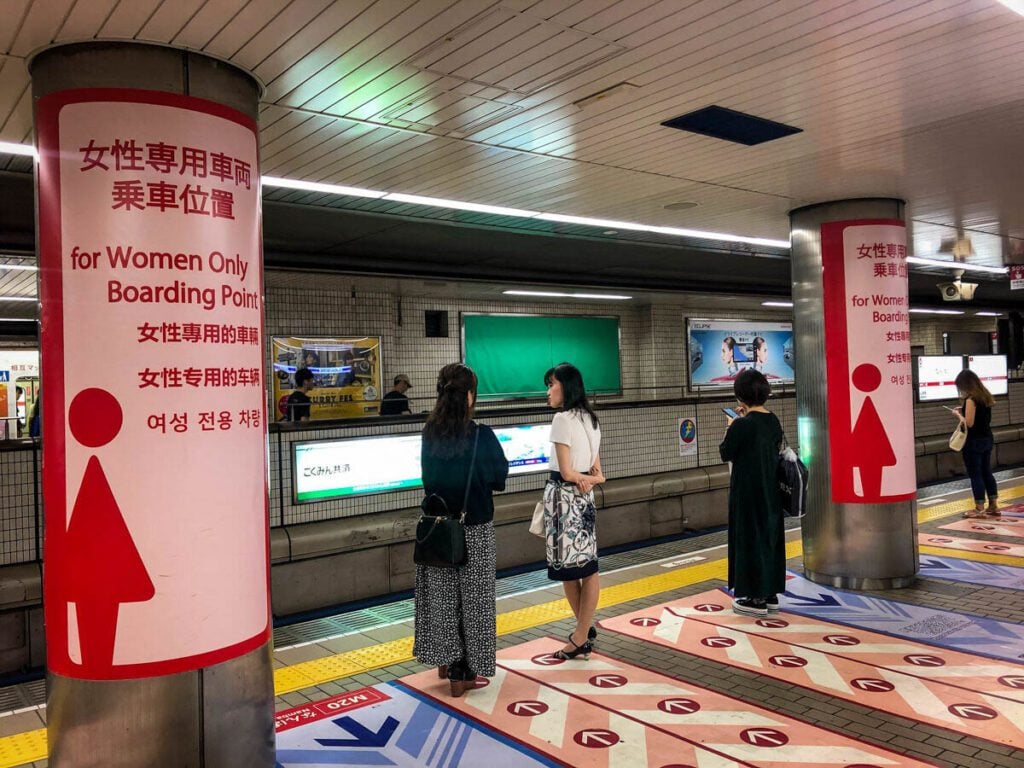
Some trains have a couple “Women Only” cars during certain hours of the day (typically during commuting times). This has been done in response to many women reporting inappropriate incidences on the trains.
If there is a “Women Only” car, it will be marked with a pink or red sign on the car as well as on the ground on the station platform. If you are a man (or traveling with one), be extra mindful about this.
24. Exit quickly
Pay attention to when your stop is approaching and prepare your things. Trains are very punctual, meaning they don’t have time to spare at stations. Gather your belongings and stand near the door as the train approaches your station to avoid a rush.
Helpful Tip: When navigating transportation, knowing the Japanese word for “excuse me” can come in quite handy. The simplest way is to say “sue-mee-mah-sen” (sumimasen).
Japanese etiquette in onsens
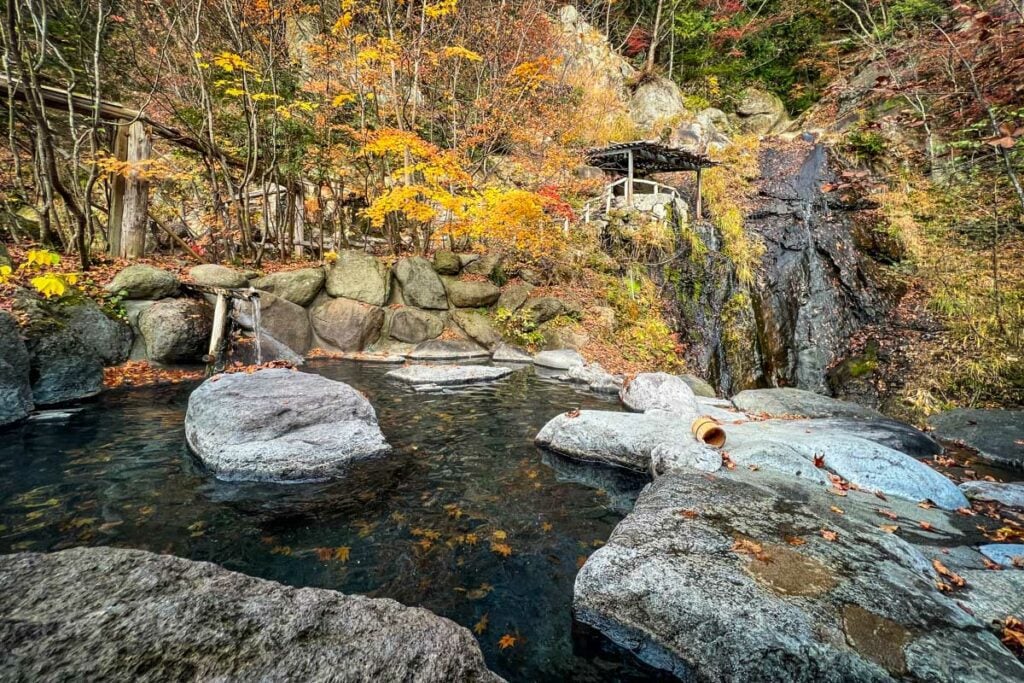
Soaking in an onsen should definitely be on your list of top things to do in Japan! But before you start shedding your clothes, there are some important rules you should know so you don’t embarrass yourself…
25. Shower before you get in
Before entering an onsen, it’s crucial to thoroughly wash and rinse off any soap or shampoo from your body. This not only ensures personal hygiene but also maintains the cleanliness of the communal hot spring water.
26. Do not wear a bathing suit

Unless otherwise noted, onsens require guests to enter without any clothing, including bathing suits. This tradition is deeply rooted in Japanese culture and allows everyone to enjoy the onsen without polluting the waters.
Many onsens are split into gendered pools or areas for this reason. And if you are shy, you can always opt to go for a private onsen, which many guest houses offer.
27. Don’t let your towel touch the water
While in the onsen, it’s customary to keep the small towel provided for modesty purposes on the side of the bath, or if needed, folded on your head. Avoid letting the towel touch the water, as it is considered unclean.
28. Tie up your long hair so it doesn’t touch the water

Long hair should be tied up to prevent it from touching the onsen water. This helps maintain the purity of the hot spring and ensures that everyone can enjoy a clean and relaxing bathing experience.
I personally like to pack a claw clip for wearing in onsen.
29. Know the onsen’s policy on tattoos
Some onsens have policies against tattoos due to their historical association with the yakuza.
Before visiting, it’s essential to check the onsen’s rules regarding tattoos. If you haven tattoos, even if they are small, you may not be permitted entry. In this case, choose onsens that are more accepting of tattooed guests or opt for a private onsen facility.
Japanese etiquette for visiting shines & temples
Before traveling to Japan, it’s very useful to understand the etiquette for entering shrines and temples.
30. Understand how to visit a Shinto shrine in Japan

A Shinto shrine, known as “jinja” in Japanese, is a sacred place that serves as a spiritual home for the kami, Shinto deities.
Recognizable by a torii gate at its entrance, a shrine features various structures, such as the honden (main hall) and haiden (worship hall), where visitors can pay their respects, make offerings, and participate in rituals to connect with the divine spirits.
There are two locations within shinto shrines where you need to do something:
At the chozuya (purification fountain)
- Bow slightly in front of the torii gate
- Approach the chozuya (water basin covered with a roof)
- Fill up a ladle with water using your right hand and rinse your left hand, and then your right hand.
- Fill up a ladle with water using your right hand, pour water into your cupped left hand and bring the water to your lips and rinse your mouth. Don’t put the ladle to your lips and don’t spit back into the basin.
- Lastly, lift the ladle vertically, letting the remaining water clean it for the next person.
At the haiden (where you pray)

- Bow slightly
- Toss a coin in the box in front of you (small coins are okay)
- Ring the bell (if there is one) two or three times to tell the gods you are here
- Deeply bow twice
- Clap twice
- Say a little prayer, or pay you respects
- Deeply bow once
31. Understand how to visit a Buddhist temple in Japan
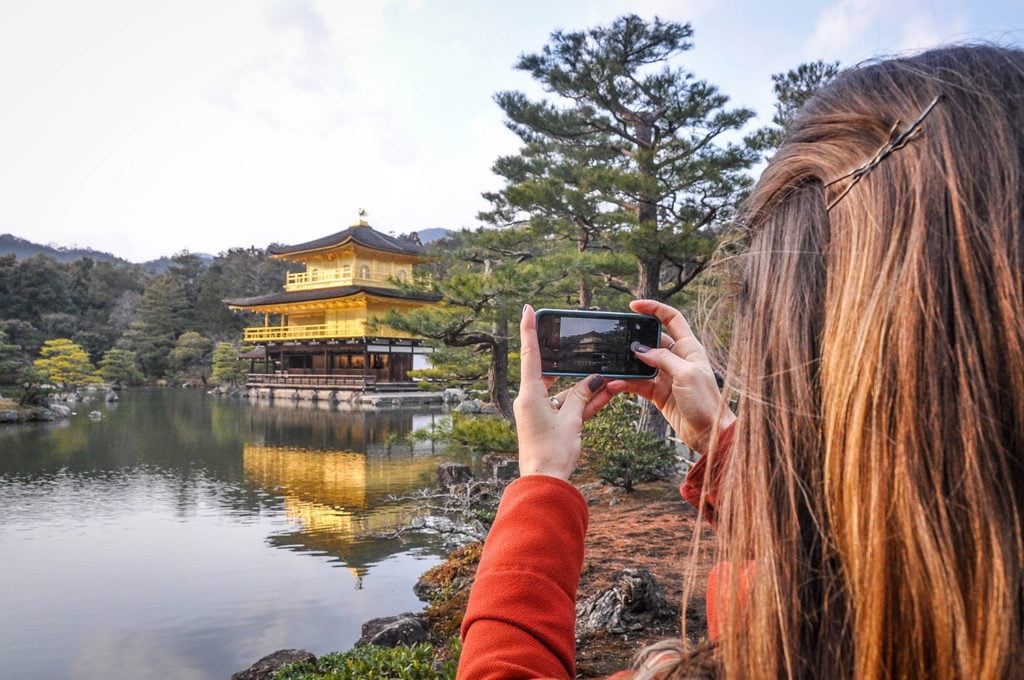
A Buddhist temple in Japan, referred to as “tera” or “ji,” is a spiritual sanctuary dedicated to Buddhist practices and teachings. Marked by architectural elements like pagodas, halls, and statues, temples serve as places of worship, meditation, and cultural heritage.
Visitors can explore serene gardens, participate in rituals, and witness religious ceremonies, experiencing the profound connection between spirituality and the rich Buddhist traditions deeply ingrained in Japanese culture.
Here are the steps for proper Japanese etiquette in Buddhist temples.
- If there is a water purification pavillion, follow the same steps as at the shrine
- Purchase a bundle of incense from the temple
- Light the bundle and wave it slightly to extinguish them
- Put the bundle in the incense burner and wave smoke towards you. Smoke is believed to have healing power.
- Approach the temple, bow slightly
- Toss a coin in the box in front of you (small coins are okay)
- Ring the bell (if there is one) 2 or 3 times
- Bring your hands together (DO NOT Clap), and pay your respects
- Bow slightly
Plan your trip to Japan
After 3 trips (and counting!), we’ve fallen head over heels for Japan—and we’ve gathered TONS of resources to help you plan your dream trip. Start with our Ultimate Japan Travel Guide and be sure to check out these helpful articles:
- First time? Our Japan Trip Planner walks you through everything you need to know.
- Use our Japan Rail Pass guide to determine if getting a train pass is optimal for your trip.
- Here’s our curated list of the best things to do in Japan—from iconic sights to once-in-a-lifetime experiences.
- Not sure where to go? Our Japan itinerary ideas will help you map it all out.
- Foodies, rejoice! This guide to what to eat in Japan will have you drooling before you land.
- This guide to what to wear in Japan (and what not to wear) will help you blend in.
- Use our ultimate Japan Packing List to make sure you don’t forget anything.
- Before you go, brush up on these essential Japan travel tips (including major do’s and don’ts!).
- Avoid awkward moments by brushing up on Japanese etiquette.
Still have questions? Drop us a comment—we LOVE helping travelers plan unforgettable trips to Japan!
Perfect Japan itinerary
Want the perfect itinerary planned for you?

If you don’t have a ton of time to spend planning your Japan itinerary (or you just don’t find travel planning fun), we’ve got something you might be interested in…
We created the ultimate done-for-you Japan itinerary that is packed full of all sorts of tips we’ve gathered from 3 trips to Japan as well as literally hundreds of hours of research (no exaggeration).
We have both an off-the-beaten path route as well as a classic itinerary that hits the top attractions (perfect for your first visit to Japan!).
Don’t miss your chance to grab our Japan packing list!
This FREE PDF download includes everything you’re going to want to pack for your Japan trip, including what NOT to bring, plus tons of insider tips!
Just enter your email and we’ll immediately send you access instructions!
Save this article to Pinterest for later!

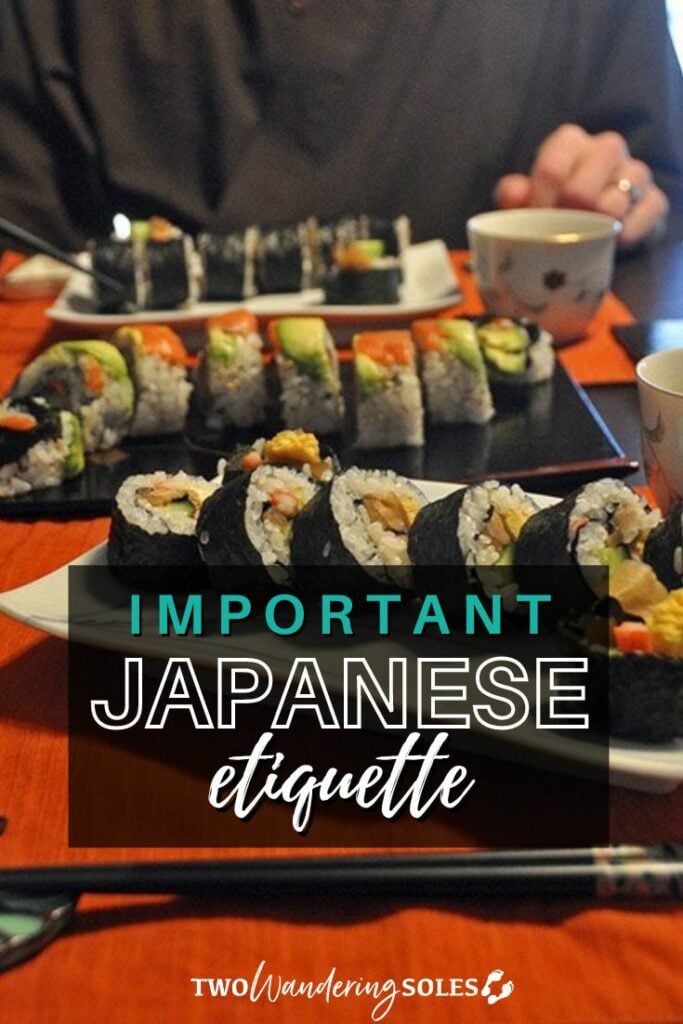
We want to hear from you!
Are any of these tips for visiting Japan surprising to you? Do you have any more Japan travel tips you think we missed? Let us know in the comments below!

